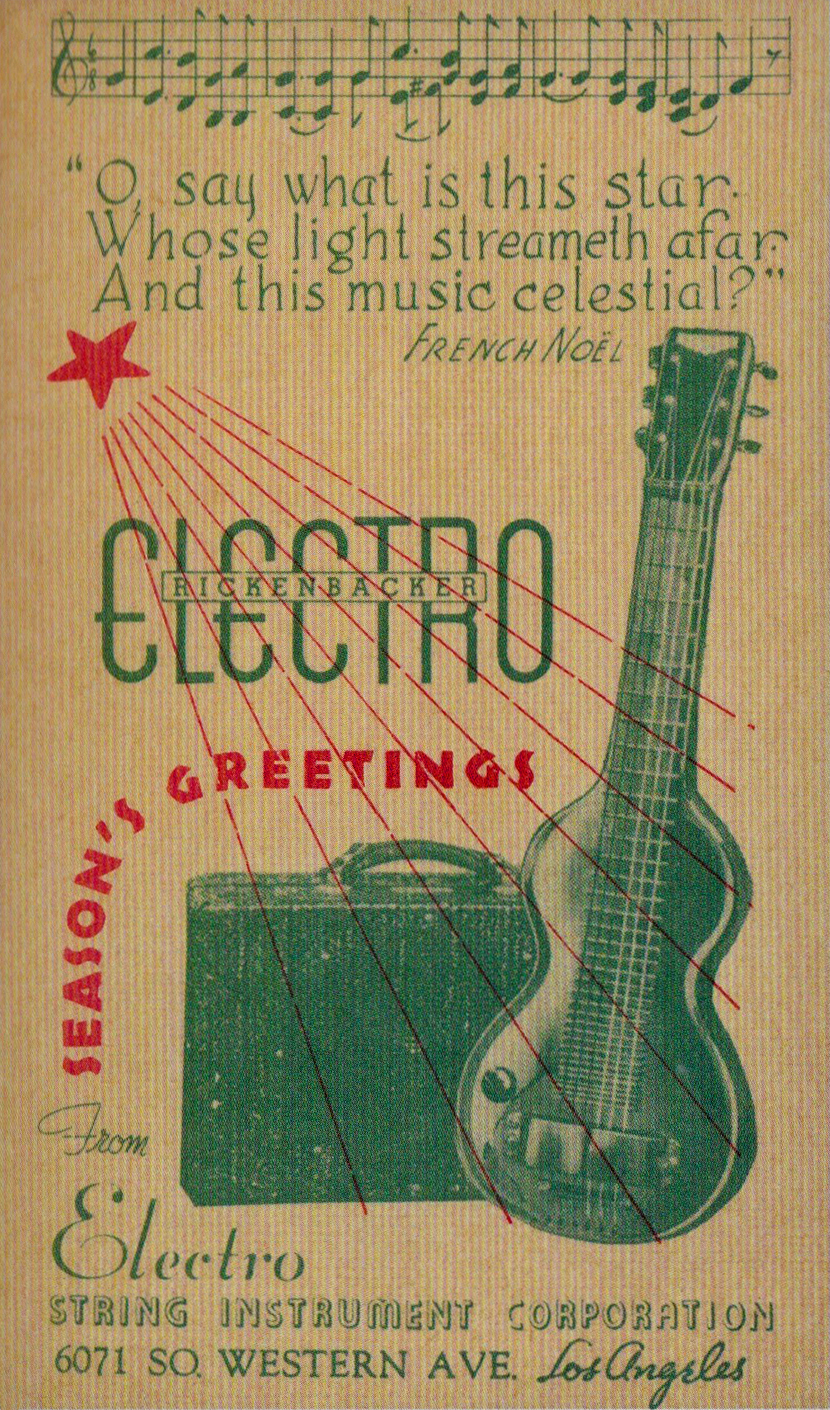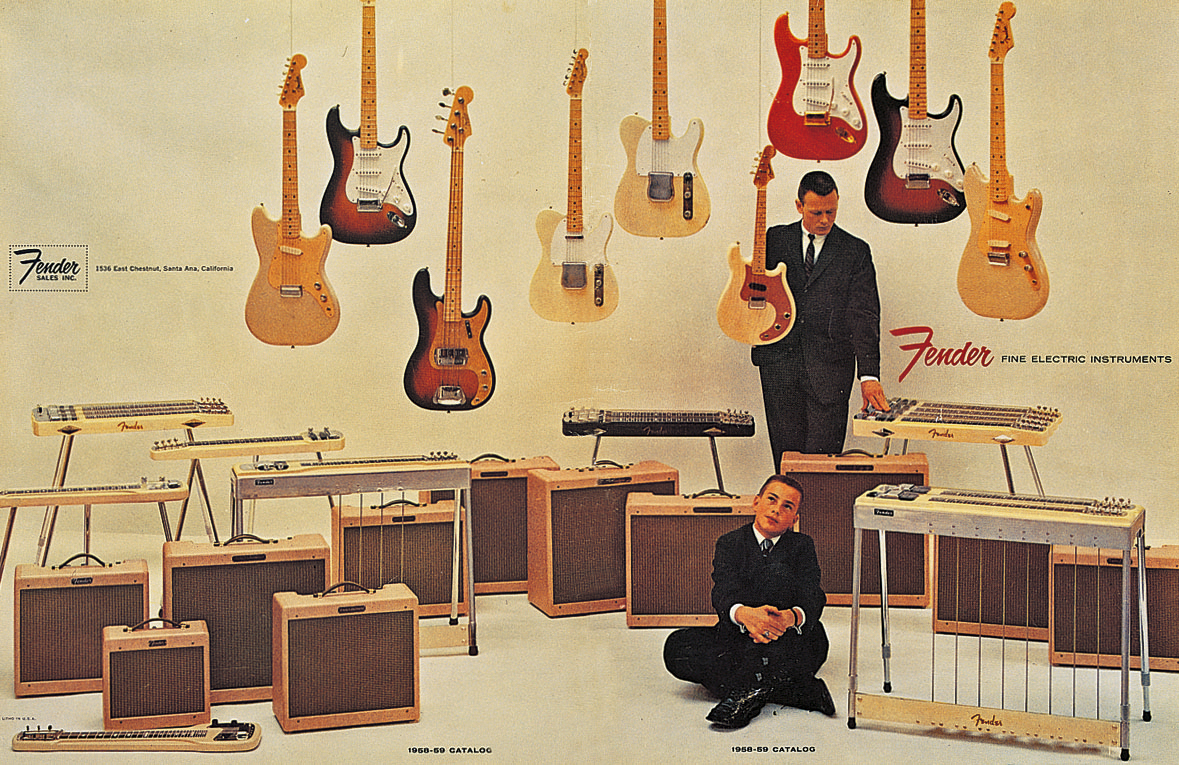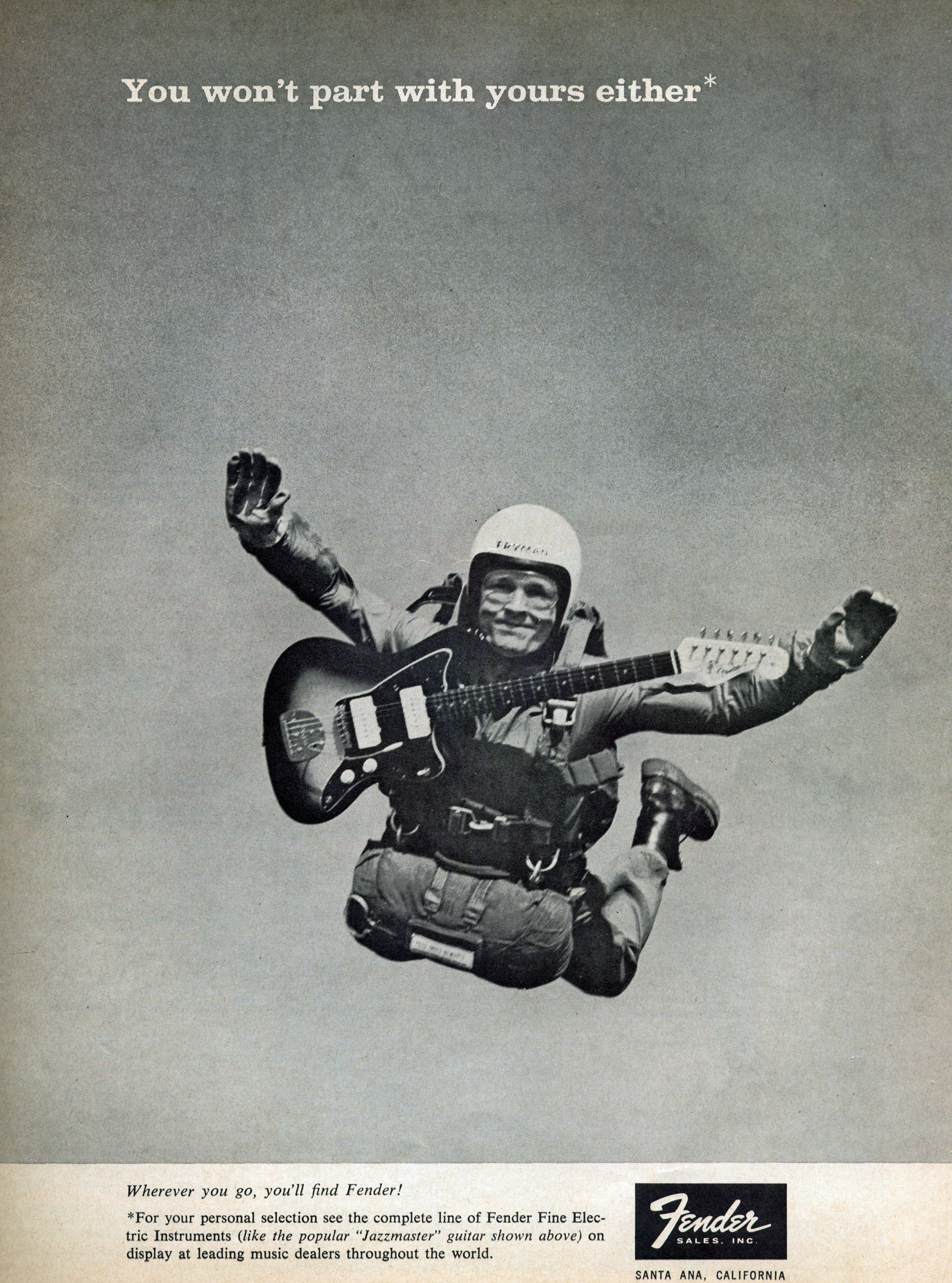One of my favorite bits of guitar memorabilia is a Rickenbacker-Electro Christmas postcard from about 1940. It shows a Silver Hawaiian steel-and-amp set and the words "Seasons’s Greetings," along with the Los Angeles address of Electro String Instrument, the early Rickenbacker company. Up top is some music notation and a few lines of what’s tagged as the suitably seasonal "French Noel."
Not only is this a small historic item from the pioneering days of electric guitars, but it’s an item attractive enough that I have it framed on a wall. But does it count as case candy? The stuff I call guitar memorabilia, others call case candy. I’ve also seen this kind of thing described, rather dismissively, as plain and simple but very inclusive "paper." As in "I’m a paper collector."

That contrasts with "case candy," a term that seems somewhat limiting when you consider all the lovely catalogues and advertisements and hang-tags and price lists and receipts and so on that a paper collector will long for. I mean, some of these items, sweet or otherwise, are unlikely to fit easily into your average guitar case.
Anyway, whatever you choose to call these items collectively, individually they have the potential to add a new dimension to guitar collecting. Period price lists can provide a snapshot of what a particular maker offered at a given time, and the prices can tell you how the various models on offer sat relative to one another in affordability.
And a hang-tag? That’s one of those small labels designed to hang from the guitar in the store and provide model details and so on. Finding the right price lists and hang-tags for your fave guitar will give it a little more period pizzazz.
Catalogs and ads—and even seasonal postcards—in some cases can be so classy and well designed that, like my little Electro item, they deserve to be framed and displayed. A big hero in the world of guitar memorabilia is Bob Perine of the Perine-Jacoby agency of Newport Beach, California. In the late ’50s, Fender turned to him to bolster its image. Bob was a keen amateur guitarist, and from then until the end of the ‘60s he created for Fender some of the most stylish and memorable guitar ads and catalogs ever printed.
One of Bob’s tasks was to devise and shoot a series of press ads, and he based them on a clever but simple idea. He decided to present a range of different Fender products, each in an unlikely setting and with the headline: "You won’t part with yours either." The message to the prospective Fender owner was that a Fender guitar or amp would be so important to you, you’d take it anywhere—just like the crazy characters in these ads.
The series began to appear in magazines in 1957, and one of the first showed a chap on the top deck of a bus holding on tight to his Telecaster, with his amp at his feet. Brave man! Many more followed in the same style: Bob snapped Fender guitars perched on an army tank, erect at a drive-in cinema, hanging in mid-air around a skydiver’s neck, or strapped to a surfer. He and his team must have had a lot of fun.
Fender’s catalogs, too, became beautiful objects under Bob’s direction. The 1958/’59 catalog was Fender’s first with a full-color cover, the front and back of which opened out to display a glorious panorama of drool-worthy gear, all eyed up by two cool crew cut guys. The booklet was a model of clear, simple design, and again, many more followed in similar fashion.
Many of the big brand names, Fender included, have changed hands through the decades, sometimes several times, and this often meant that any archives they might have owned were lost as the new owner had a clear-out. Ouch! Martin, however, is proud of its status as one of the longest-running companies in American guitar history, and continuous family ownership means it’s maintained an archive of precious material.

When I worked on the first edition of Walter Carter’s book about Martin that I helped to publish back in 1995, I spent a happy day at the company’s HQ in Nazareth, PA, overseeing photography of guitars and material from their enviable collection. There were many star items—any of which a Martin collector would die for—among them a stack of ledgers from the 1830s documenting the earliest sales of the brand new enterprise.
My own favorite was a ledger from a hundred years later, dated 1933, in which a clerk logged among one Wednesday’s business the sale of Martin’s very first D-45. On March 22, just below a note of some strings going to a store in Ohio, he or she wrote: "Chicago M.I. Co., Chicago, Ill., 1 Gtr D-45, $80.00, Special fgbd inlaid ‘Gene Autry’." That historic guitar resides today at the Autry Museum Of The American West in Los Angeles, no doubt insured for rather more than 80 bucks, and the ledger is still safely tucked away at Martin HQ.
Of course, items like those will never be available to collectors. But even with the material that does come up for sale, not everyone can afford the elevated prices that some memorabilia commands these days. One excellent resource I use regularly when I want to look up a catalog or price list I don’t own or have a copy of is VintAxe.com, which Steve Brown launched in 2003.
"The primary feature of VintAxe is the Vintage Catalog Library," Steve explains. "Today, it contains catalog images of 640 electric guitar brands, 182 acoustic brands, and 115 amplifier brands. The electric catalogs include guitars made in the USA, Europe/Canada, and Asia, while the acoustic section emphasizes pre-1940 instruments." For a small fee, subscribers can view the images in the VintAxe collection to help identify their own instruments, or deepen their knowledge of guitar history, or both.
Inevitably, Steve finds it harder these days to locate fresh items for the library than when he started VintAxe 20 years ago. Back then, the mom-and-pop stores that were being driven out of business often had piles of unwanted material to dispose of. "My largest single-day purchase was from a dealer in Iowa liquidating her parents’ music shop," Steve recalls. "She came to my house with four file-cabinet tubs of old catalogs and left with two. I’ve also purchased boxes of catalogs from many other music stores, notably Top Shelf Music of Buffalo, New York."

VintAxe represents a valuable resource, though Steve says he’s rarely spent large sums putting it together. "Of course, catalog prices tend to follow the prices of the guitars they advertise, so early Fender, Gibson, Martin, and Rickenbacker items bring hefty asking prices. Probably the maximum I’ve ever spent on a single item is $400 to $500, and the main one I remember is the 1935 Grossman distributor catalog, which I bought for $450."
He calls it the granddaddy of all pre-World War II catalogs, and you can tell why. "It features Martin, Gibson, National, Vega, Dobro, Regal, LaSalle, Cromwell, Kay, Kay Kraft, Kleartone, and Norwood guitars."
Is there a holy-grail item he’s still searching for? Or perhaps one that got away? "Ah, the 1967 Hallmark Swept-Wing brochure," he says with a smile. "I saw one for sale in my early collecting life and got outbid, because I didn’t realize how rare it was. I haven’t seen another for sale since. It qualifies as a holy-grail item with strong historical value because Hallmark has such a convoluted guitar-making history and the Swept-Wing is such a counter-intuitive, unconventional American guitar design."
Not all catalogs, ads, and the rest were so obviously significant. Smaller makers with smaller budgets made do with perfunctory leaflets and modest shout-outs, often without pictures and bearing little evident design work. But occasionally, if there’s some info beyond the usual hype, these vintage items can provide a rare window into the thinking behind the touted gear.
A small and seemingly mundane text-only ad in a 1974 edition of Guitar Player magazine noted Lawrence Di Marzio’s address on Staten Island along with the news that his $35 Super Distortion Humbucker would "make your humbucking pickup the hottest pickup on the market," and that for an extra $5 he’d make one to your own specifications. Larry listed three players who liked his stuff, too: "Used by Rick Derringer, Ronnie Montrose, and Earl Slick of David Bowie’s band." How about that? An insight into the early years of the replacement-pickup industry, right there on an old piece of paper, and I love it.
About the author: Tony Bacon writes about musical instruments, musicians, and music. His books include Legendary Guitars and Electric Guitars: Design & Invention. Tony lives in Bristol, England. More info at tonybacon.co.uk.
